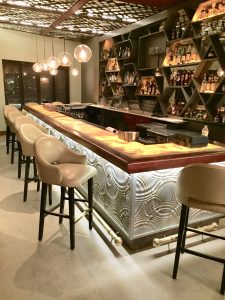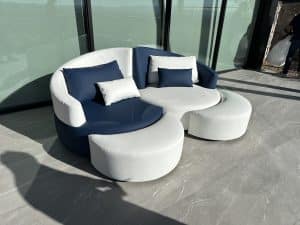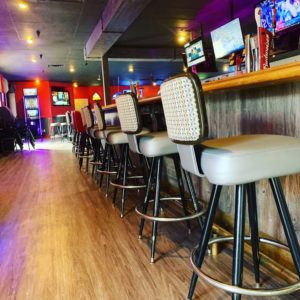


10 Furniture Trends to Impress Your Friends in 2025

Old furniture doesn’t have to stay old. In fact, with reupholstery, you can update worn-out pieces and make them look brand new again.
Want to learn more? This post explains what furniture reupholstery is and highlights three examples of reupholstered pieces.
Furniture reupholstery is the process of replacing the fabric, padding, and other components of a piece of furniture to update its appearance and make it more comfortable.
Just to be clear: Reupholstery furniture services extend well beyond simply updating fabric. They often involve repairing or replacing very intricate components, not to mention careful furniture disassembly, precise measuring and cutting of materials, and using specialized tools.
Reupholstering furniture is particularly useful for furniture with sentimental value, old but well-made items that need an update, or unique pieces that are hard to replace. It’s also ideal for furniture that fits perfectly in your space but requires an updated look to match a new style.
Furniture reupholstery has a long and storied history, having evolved over many centuries from basic padding to today’s advanced reupholstery techniques.
Ancient Beginnings:
Centuries ago, the first kinds of upholstery were produced by ancient Egyptian, Greek, and Roman societies. They relied on animal hides and woven plant fibers to make primitive cushions and seat coverings. Moreover, they experimented with stuffing materials like grass, leaves, and even feathers.
Medieval and Renaissance Developments:
Following the fall of the Roman Empire in the 5th century AD, there was a long period where upholstery techniques didn’t progress significantly in the Western world. It wasn’t until the Middle Ages that upholstery made a large leap forward.
During this period, tapestries were used to cover chairs and benches, and cushions were filled with horsehair. Then, during the Renaissance, leather in upholstery and more complex padding techniques were introduced.
17th and 18th Century Developments:
In the 17th century, upholstery saw significant advancements in stuffing techniques. By the early 18th century, fully upholstered chairs emerged, and artisans perfected techniques for contouring cushions and applying fabrics.
Industrial Revolution and Mass Production:
The Industrial Revolution of the 19th century further reshaped upholstery. This was when coiled springs were introduced, and manufacturers adopted new materials like cotton wadding.
Additionally, mass production made upholstered pieces more affordable and accessible.
20th Century Innovations:
In the 20th century, upholstery was again changed by the introduction of synthetic fabrics, foam padding, and modern adhesives.
Reupholstery Today:
Today, despite numerous technological advancements, reupholstery still depends on skilled craftsmanship. Upholsterers continue to work by hand to restore and update furniture.
However, modern innovations have enhanced the process, giving craftsmen access to advanced materials, tools, and technology that allow for greater precision and efficiency while maintaining the timeless quality and attention to detail that defines the craft.
While these terms are sometimes used interchangeably, they are different from each other.
Furniture Upholstery
Furniture Reupholstery
Reupholstering
Recovering
A custom slipcover is a removable fabric cover that fits over existing upholstery. Slipcovers are less expensive and can be easily changed or washed, but they don’t address any issues with the furniture’s padding or structure.
Here’s a detailed comparison between reupholstery and custom slipcovers:
Reupholstery
Custom Slipcover
Outdoor furniture reupholstery presents unique challenges due to exposure to the elements. Fortunately, these lounge chairs are designed to withstand outdoor conditions while maintaining a stylish appearance.
See more examples of reupholstery in our Residential Outdoor Furniture Gallery.
Sofa reupholstery can significantly enhance a room’s atmosphere. These sofas were refreshed with new materials and design touches, resulting in improved comfort and an updated look.
See more examples of reupholstery in our Residential Sofas and Love Seats Gallery.
Commercial reupholstery requires durability and style. For these restaurant booths, we chose materials that would ensure long-lasting performance and align with the overall aesthetic of the space. The result is booths that elevate the restaurant’s interior.
See more examples of reupholstery for commercial restaurants in our Commercial Restaurants Gallery.
Answer: Difficult.
While basic reupholstery can be tackled as a DIY project, more advanced work requires high-level expertise and experience. For instance, achieving a smooth, wrinkle-free finish demands accurate measuring, cutting, and fabric fitting. This also requires using specialized tools and understanding various padding types and furniture designs.
When it comes to full custom reupholstery, especially for valuable or sentimental pieces, professional help is necessary to achieve the best outcome. Reupholstery furniture experts are skilled in handling intricate details such as tufting, piping, and nailhead trim.
Assessment: This is where the upholsterer assesses the furniture and discusses its needs with the client.
Fabric selection: The upholsterer works with the client to choose the right fabric for their needs.
Disassembly: The piece is disassembled so that the upholsterer can access all its components.
Repair: This step requires fixing any issues with the frame.
Rebuilding: The upholsterer replaces padding, springs, and other elements as needed.
Upholstering: This is where the upholsterer applies the new fabric and any decorative elements.
Finishing: The upholsterer adds the final touches and ensures all elements are secure and properly aligned.
For reupholstery furniture services that breathe new life into your furniture, consider Redesign Upholstery. Our skilled craftsmen work with a wide variety of furniture, from sofas and loveseats to dining chairs, armchairs, and recliners. We can also reupholster ottomans, footstools, headboards, bed frames, antique pieces, and more.
No matter the item, our team is ready to bring new life to your favorite furniture with expert craftsmanship and quality materials.
Benefits of Reupholstery with Redesign Upholstery
Choosing reupholstered furniture over buying new offers key benefits, such as extending the life of well-crafted pieces, reducing waste, and maintaining sentimental value. It also allows for complete customization in terms of fabric and design.
Additionally, for those with family heirlooms and antiques, reupholstery provides a way to maintain original craftsmanship while giving the piece a fresh, updated look.
Expertise and Personalization
Whether you’re looking to update a single piece or refurbish an entire set, our team has the expertise needed to exceed your expectations. We understand that your furniture is more than just functional – it’s a part of your home.
Let us help you write the next chapter with beautifully reupholstered furniture that combines the charm of the old with the freshness of the new.
Free Consultations and Customization
Want to get started? We provide free consultations to assess your furniture and explore your options. We offer full customization to match your unique style and strive for timel completion of all projects. We stand behind our work, ensuring you’re delighted with the final result.
You can learn more about Redesign Upholstery on our About page, including our history and mission.
Visit our Home page to learn more about our services and how we can transform your furniture.


